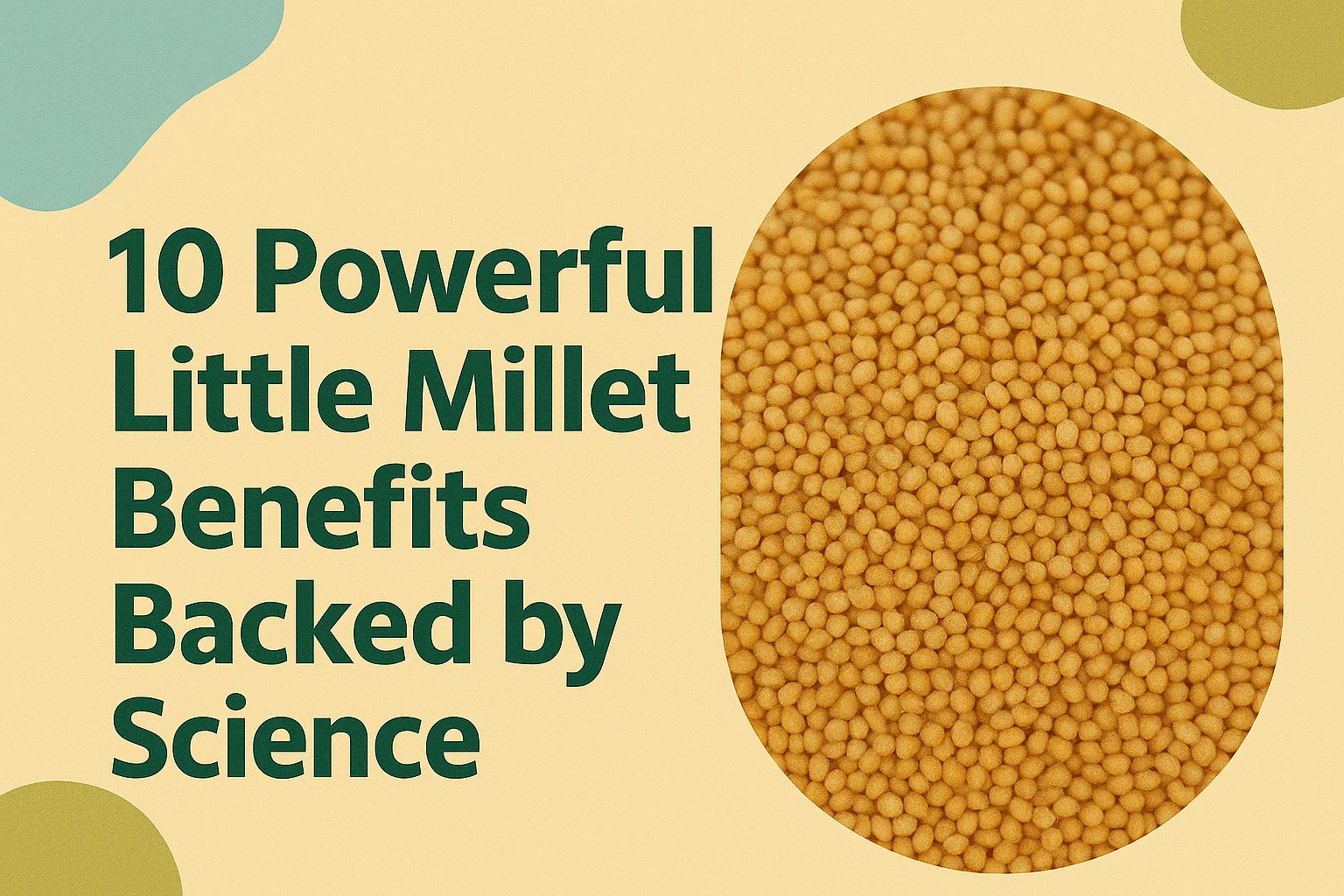Little millet, a small-grained ancient cereal, has been a part of traditional Indian diets for centuries. In recent years it has regained attention for its nutrient-dense profile and impressive health benefits. Packed with fiber, protein, essential minerals and antioxidants, little millet is an excellent alternative to rice and wheat especially for people aiming for a healthier low-glycemic diet. In this article we’ll explore 10 powerful little millet benefits, its nutritional profile, and insights into little millet benefits and side effects so you can make an informed choice before adding it to your daily meals.
What Is Little Millet?
Little millet (Panicum sumatrense) is one of the oldest cultivated grains in India. It belongs to the millet family which also includes foxtail, barnyard, kodo and finger millet. Known as samai in Tamil, kutki in Hindi and chama in Malayalam, this tiny grain is a resilient crop that grows in dry regions with minimal water making it a sustainable food choice.
Beyond its environmental advantages, little millet stands out for being gluten-free, rich in dietary fiber and packed with essential micronutrients making it a perfect option for modern health-conscious individuals.
Nutritional Profile of Little Millet
Before diving into the little millet benefits, let’s look at its impressive nutritional composition per 100 grams of raw grain (approximate values):
| Nutrient | Amount |
| Calories | 207 kcal |
| Protein | 7.7 g |
| Carbohydrates | 67 g |
| Dietary Fiber | 7.6 g |
| Fat | 4.7 g |
| Calcium | 17 mg |
| Iron | 9.3 mg |
| Phosphorus | 220 mg |
| Magnesium | 81 mg |
| Glycemic Index | 41 (Low) |
This nutrient profile clearly shows why nutritionists often emphasize little millet health benefits. The grain’s low glycemic index and rich mineral content make it suitable for diabetics, weight watchers and those seeking heart-healthy foods.
What are the Benefits of Little Millet?
1. Helps Regulate Blood Sugar Levels
One of the most important little millet benefits is its ability to regulate blood sugar. The high fiber and low glycemic index of little millet slow down glucose absorption in the bloodstream preventing sudden sugar spikes.
A 2021 study published in the Journal of Food Science and Technology found that incorporating millets like little millet into the diet improved post meal blood glucose response in type 2 diabetic patients.
Replacing polished white rice with cooked little millet in lunch or dinner can significantly improve glycemic control over time.
Thus when discussing little millet health benefits, its anti-diabetic potential stands out as one of the most valuable.
2. Supports Weight Loss Naturally
Another amazing little millet benefit is its role in weight management. Its high fiber content keeps you full for longer reducing overeating and unhealthy snacking. The complex carbohydrates digest slowly maintaining energy levels without unnecessary calorie spikes.
Having a bowl of little millet upma or khichdi for breakfast can help you stay full until lunch reducing mid morning cravings.
Scientific studies indicate that regular consumption of high-fiber millets contributes to reduced body mass index (BMI) and improved metabolic health proving how little millet benefits mostly favor those pursuing sustainable weight loss.
3. Promotes Heart Health
Heart health is another crucial aspect when discussing little millet health benefits. The grain’s rich magnesium and potassium content helps maintain normal blood pressure while its fiber helps reduce bad cholesterol (LDL).
A high-fiber diet is known to improve lipid profiles and reduce the risk of cardiovascular diseases. Since little millet is naturally gluten-free and low in saturated fats, it’s a heart-friendly food that fits well into a balanced diet.
Replacing refined grains with little millet in at least three meals a week can help lower cholesterol levels and improve cardiac function over time.
4. Boosts Digestive Health
Digestive wellness is one of the most immediate little millet benefits you will experience after regular use. Its insoluble fiber aids smooth bowel movement and prevents constipation. Additionally the prebiotic properties of millet fiber promote healthy gut bacteria supporting long-term digestive health.
Including little millet porridge in your diet during breakfast can help regulate digestion and ease bloating especially for individuals with sensitive stomachs.
5. Strengthens Bones and Muscles
Rich in phosphorus, calcium and magnesium, little millet contributes to bone and muscle health. Phosphorus plays a vital role in bone formation while magnesium supports muscle contraction and relaxation.
Regular consumption of this millet variety can be particularly beneficial for children, women and the elderly who need strong bones and muscles.
A warm bowl of little millet kheer or dosa can serve as a nourishing calcium-rich meal for growing kids.
This bone-supportive role adds further weight to the scientific evidence behind little millet health benefits.
6. Enhances Immunity and Fights Inflammation
Antioxidants like phenolic acids and flavonoids present in little millet combat oxidative stress which is one of the main causes of chronic inflammation and weakened immunity.
These compounds neutralize free radicals protecting cells from damage and improving the immune response.
Adding a little millet to your daily diet can help reduce oxidative stress thereby lowering the risk of diseases like arthritis, heart ailments and premature aging.
7. Improves Energy and Stamina
Unlike refined grains that cause sudden energy crashes, little millet provides sustained energy due to its slow-digesting complex carbohydrates. Athletes and active individuals often prefer millets for their steady energy release and high iron content.
Iron aids in hemoglobin formation ensuring proper oxygen transport to muscles and organs enhancing endurance levels naturally.
If you’re looking for a gluten-free energy food, you can’t miss out on little millet benefits in boosting stamina and reducing fatigue.
8. Supports Better Skin and Hair Health
Among the lesser-known little millet health benefits, its role in promoting glowing skin and healthy hair deserves attention. The antioxidants, iron and B-vitamins in little millet nourish skin cells and improve blood circulation giving a natural glow.
The iron content helps combat hair loss by improving oxygen supply to hair follicles. Zinc and magnesium also play roles in collagen production and scalp health.
A diet rich in little millet can help improve dull skin tone and reduce hair thinning caused by nutrient deficiencies.
9. Helps Manage PCOS and Hormonal Imbalances
For women one of the most significant little millet benefits lies in its positive effect on hormonal balance. Due to its low glycemic index and high fiber content, little millet helps regulate insulin levels which is a key factor in managing PCOS (Polycystic Ovary Syndrome).
Consuming millets instead of refined carbs may reduce insulin resistance and stabilize hormonal fluctuations promoting reproductive health.
Women with PCOS can replace white rice with little millet in their meals for better insulin sensitivity and menstrual regulation.
10. Eco-Friendly and Sustainable Choice
Beyond its nutritional value little millet is a crop that truly cares for the planet. It thrives with minimal water, grows well even in dry and less fertile soils and requires very little maintenance compared to conventional grains. This makes it an environmentally sustainable alternative for both farmers and consumers.
Farmers benefit immensely from little millet’s short growing cycle and low input costs which not only support their livelihood but also promote food security in regions prone to drought. By choosing little millet over water intensive crops like rice you are making a conscious and impactful decision, one that supports sustainable agriculture while protecting the environment for future generations.
Little Millet Benefits and Side Effects
While there are numerous benefits it’s also important to consider the possible side effects to maintain a balanced perspective.
Possible Side Effects
Thyroid Concerns:
Overconsumption of any millet including little millet may interfere with thyroid hormone absorption due to goitrogenic compounds. This doesn’t mean you have to avoid it — just enjoy it in moderation especially if you have thyroid-related conditions.
Digestive Discomfort:
A sudden increase in fiber from little millet can lead to temporary bloating or gas. To prevent this, introduce it gradually into your meals and ensure you drink plenty of water throughout the day.
Allergic Reactions (Rare):
Though little millet is naturally gluten-free and safe for most people, those with specific grain allergies should consult a healthcare professional before making it a regular part of their diet.
How to Avoid Side Effects?
Soak Before Cooking:
Always soak little millet for a few hours before cooking to reduce anti-nutrients like phytic acid, which can interfere with mineral absorption.
Pair with Vitamin C-Rich Foods:
Combine little millet with foods high in vitamin C such as oranges or bell peppers, to enhance iron and nutrient absorption naturally.
Maintain Portion Control:
Moderation is key, about half to one cup of cooked millet per meal is considered ideal for most adults.
How to Include Little Millet in Your Diet?
Here are a few easy and delicious ways to make little millet a part of your daily meals:
Little Millet Upma:
A fiber-rich and nutritious alternative to regular semolina upma. It keeps you full longer while supporting digestion and energy levels throughout the day.
Little Millet Khichdi:
Cook it with lentils, vegetables and mild spices for a wholesome, comforting one-pot meal that’s perfect for lunch or dinner.
Little Millet Pongal:
A light and healthy South Indian favorite that can be enjoyed for breakfast or as a simple dinner offering both taste and nutrition.
Little Millet Dosa or Idli:
Replace rice with little millet in your batter for a gluten-free twist on classic dosa or idli — soft, tasty, and easy to digest.
Little Millet Salad:
Mix cooked and cooled millet with cucumbers, tomatoes, onions, and a splash of lemon juice for a refreshing, protein-rich salad.
Regular inclusion in your diet ensures you fully enjoy the wide range of little millet health benefits.
Conclusion
From stabilizing blood sugar to promoting heart, digestive and bone health, the little millet benefits are truly impressive and well supported by modern nutritional science. It’s not just a humble grain from our ancestors but a superfood for today’s lifestyle offering health, sustainability and taste in one package.
While mild side effects may occur with excessive intake, mindful and moderate use makes little millet a powerhouse of wellness. Whether you’re managing diabetes, aiming for weight loss or simply looking to improve your overall nutrition, this ancient grain deserves a place on your plate.
Key Takeaway
Incorporating little millet into your daily meals is an easy yet powerful way to boost your health naturally. Its rich nutrient content, low glycemic index and numerous scientifically backed benefits make it one of the most valuable grains for modern living.
Frequently Asked Questions
1. Is little millet good for people with diabetes?
Yes. Little millet has a low glycemic index, which means it releases sugar slowly into the bloodstream. This helps manage blood sugar levels and makes it a smart grain choice for people with diabetes.
2. Can little millet help with weight loss?
Yes. The high fiber content in little millet keeps you full for longer and reduces food cravings. Replacing white rice or refined grains with little millet can support healthy weight management over time.
3. How does little millet improve heart health?
Little millet is rich in magnesium, potassium, and antioxidants, which help lower cholesterol levels and support normal blood pressure. Regular consumption may reduce the risk of heart disease and promote better cardiovascular function.
4. Can I eat little millet every day?
Yes. You can safely include little millet in your daily diet. It’s light, easy to digest, and can be used in many dishes like khichdi, upma, dosa, or porridge. Just ensure a balanced diet with other whole grains and vegetables.
5. What are the best ways to include little millet in meals?
You can cook little millet like rice or use it in upma, pongal, salads, and soups. It can also be ground into flour for dosas, idlis, or rotis. The grain’s mild flavor blends easily with both sweet and savory recipes.
6. Does little millet help with hormonal balance or PCOS?
Yes. The high fiber and low glycemic index of little millet help regulate insulin levels, which in turn supports hormonal balance. It can be beneficial for women dealing with PCOS when included in a balanced diet.




